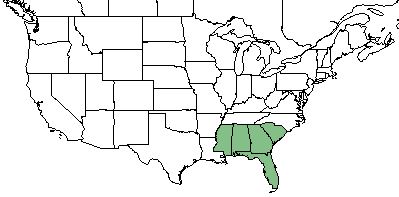Difference between revisions of "Hypericum myrtifolium"
| Line 1: | Line 1: | ||
{{italic title}} | {{italic title}} | ||
| + | Common name: myrtleleaf St. Johnswort <ref name= "USDA"/> | ||
<!-- Get the taxonomy information from the NRCS Plants database --> | <!-- Get the taxonomy information from the NRCS Plants database --> | ||
{{taxobox | {{taxobox | ||
Revision as of 20:09, 12 June 2018
Common name: myrtleleaf St. Johnswort [1]
| Hypericum myrtifolium | |
|---|---|

| |
| Photo by the Southeastern Flora Plant Database | |
| Scientific classification | |
| Kingdom: | Plantae |
| Division: | Magnoliophyta - Flowering plants |
| Class: | Magnoliopsida - Dicots |
| Order: | Theales |
| Family: | Clusiaceae |
| Genus: | Hypericum |
| Species: | H. myrtifolium |
| Binomial name | |
| Hypericum myrtifolium L | |

| |
| Natural range of Hypericum myrtifolium from USDA NRCS Plants Database. | |
Contents
Taxonomic Notes
Synonyms: none
Varieties: none
Description
H. myrtifolium is a native perennial shrub that is a member of the Clusiaceae family. [1] It is most recognizable by its clasping leaves, which are usually glaucous. [2]
Distribution
H. myrtifolium is found mainly in Florida, but can also be found sparingly in southern Alabama, Gerogia, and Mississippi. [1]
Ecology
Habitat
H. myrtifolium is naturally found in fresh-water communities and marshes infrequently. [3] Other natural communities include sandhills and flatwoods. [4]
Phenology
H. myrtifolium flowers from May to June as well as November to December. [5].
Conservation and Management
Cultivation and restoration
Photo Gallery
References and notes
- ↑ 1.0 1.1 1.2 USDA Plants Database URL: https://plants.usda.gov/core/profile?symbol=HYMY
- ↑ Carr, L. G. (1940). "Further notes on coastal floral elements in the bogs of Augusta County, Virginia." Rhodora 42(495): 86-93.
- ↑ Hilmon, J. B. (1964). "Plants of the Caloosa Experimental Range " U.S. Forest Service Research Paper SE-12
- ↑ Platt, W. J., Gregory W. Evans, and Mary M. Davis (1988). "Effects of Fires Season on Flowering of Forbs and Shurbs in Longleaf Pine Forests." Oecologia 76(3): 353-363.
- ↑ Panflora URL: http://www.gilnelson.com/PanFlora/